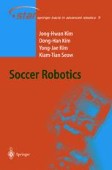Search
Search Results
-
6 The Modified Taught Data Method
In order to realize the movement of an industrial robot, the given objective trajectory is always used without any change when their coordinate...
-
15. SIMULATION STUDIES AND REAL-TIME CONTROL USING MATLAB/SIMULINK
The MATLAB programs for simulating the generalized minimum variance (GMV) controller with the CE assumption as well as its dual version are presented...
-
13. ROBUSTNESS AGAINST UNMODELED EFFECTS AND SYSTEM STABILITY
Various engineering systems are described by complex dynamic models that include nonlinearities, time-varying parameters and high-order terms....
-
6. DUAL POLE-PLACEMENT CONTROLLER WITH DIRECT ADAPTATION
The following two problems have to be solved in order to extend the adaptive dual control approach to direct adaptive pole-placement control systems:...
-
9. A SIMPLIFIED APPROACH TO THE SYNTHESIS OF DUAL CONTROLLERS WITH INDIRECT ADAPTATION
The cost function of the deviation between the system output and its nominal value (system response to the unknown desired controller), suggested by...
-
12. APPLICATION OF DUAL CONTROLLERS TO A LABORATORY SCALE VERTICAL TAKE-OFF AIRPLANE
The application of dual control with direct adaptation to the roll-angle control of a laboratory scale vertical take-off airplane (Patra et al.,...
-
Vision Based Motion Planning of Humanoid Robots
Vision is the most effective sensing form for humans in understanding their environment, recognition of the objects around them and navigating from...
-
Evolution of Locomotion Controllers for Legged Robots
The construction of a locomotion controller for legged robots is a difficult and time consuming process. This task can be automated through the use...
-
Thresholding Segmentation and Classification in Automated Ultrasonic Testing Image of Electrical Contact
This paper is concerned with the thresholding segmentation of ultrasonic C-scan image for defect with artificial intelligence and support vector...
-
4. How to Decide and Act? Use Intelligent Systems and Control Techniques
In robot soccer, the game situation in the playground is typically read in terms of the robots’ postures and the ball’s position. Using real-time...
-
Fuzzy-Neural Impedance Control for Robots
In conventional impedance control, the difficulties encountered in obtaining an exact system dynamic model and selecting its impedance parameters...
-
Adaptive Robust Fuzzy Tracking Control for a Class of Nonlinear Systems
The tracking control problem for a class of nonlinear systems with uncertain system function and uncertain gain function, which are the unstructured...
-
Robust Stability of Interval Lur’e Systems: A Bilinear Matrix Inequality Approach
This paper provides a sufficient condition for an interval Lur’e system to be globally exponentially stable with a dam** factor. The Lur’e system...
-
3-D Grasp Analysis and Synthesis Using the Ray-Shooting Technique
The ray-shooting technique is a powerful tool for handling geometric information in Computational Geometry and Computer Graphics. This chapter...
-
Intelligent Technologies for Robotic Welding
This paper discusses intelligent technologies for the robotic welding, which contains computer vision sensing, automatic programming for weld path...
-
The Seam Tracking System for Submerged Arc Welding
The structure and the principle of seam tracking for submerged arc welding were introduced in this paper. The method of seam recognition with...
-
Preliminary Probe of Embedded Real-Time Operating System and Its Application in Welding Control
This paper firstly introduces the concept of real-time and embedded system, then analyses the character of welding and the advantages of adopting...
-
Dependability of Mobile Robots in Direct Interaction with Humans
Operating interactive mobile robots in unmodified natural environments such as in museums or at exposition areas impose requirements on the robots,...
-
Next Generation Teach Pendants for Industrial Robots
Teach pendants for industrial robots have sometimes been quite rudimentary in the past, and often enough users had to learn to cope with whatever is...
-
4 Co-existence: Physical Interaction and Coordinated Motion
Co-existence an co-operation between a human and a machine which can move and act in an autonomous mode involves a form of interaction which goes...
